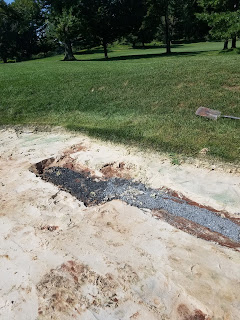With the damage that occurred to our Bermuda grass this past
season, we are working to find any improvements that are possible. While most
of the damage was unpreventable, it is our plan to do all we can to give the
Bermuda grass the best chance at survival. One step we will be taking this year
is starting a multi-year test of over seeding some tee boxes.
One unique factor that damaged the Bermuda grass last year
was desiccation. The winter of 2017-2018 was very cold. It was also very windy
at times, particularly a stretch from late December through mid-January.
Dormant Bermuda grass still needs water in the reproductive parts of the plant
that are underground. Dehydration can cause these tissues to die just as easily
as other factors. Moreover, the tee boxes are sand based, which allows for
excellent drainage. In the case of this past winter, the tees drained just as
they were supposed to and the wind dried out the rest. We believe this desiccation
was an additional detriment to the tees that was not seen or was much less
severe on other Bermuda grass around the course.
Enduring as much rain as we have this year, it can be hard
to imagine that we would need to add more water at any point. But part of our
strategy is to keep the Bermuda grass more hydrated as it enters dormancy. Once
we shut down our irrigation system, we cannot add any more water, but we are maintaining
a certain level of moisture in the soil for as long as we can.
In addition to more hydration, we will be over seeding with
annual ryegrass, 4 individual tee boxes as a test. This test will be a minimum
of 3 years so that we can accurately judge its effectiveness.
However, the test
may need to be shortened or extended depending on our results; 3 years is not
set in stone. If the winters prove to be benign and there is no or very little
Bermuda grass damage in general, then an accurate assessment of the test cannot
be made. Similarly, if the 3 winters of the test are all too different to
compare to one another, more years may need to be added. Lastly, if after 2
years, we see that we are making the Bermuda grass worse by over seeding, we
may also end the test.
This test does not constitute the beginning of a new
standard. We are not guaranteeing an over seeding program. We are also not
planning any over seeding of fairways at this time. The cost of such a program
would far outweigh the benefits as we currently stand. Also, of the many causes
of Bermuda grass damage on fairways, we do not believe desiccation played as
great a role in the fairways as it did on tees.
The other factor that over seeding may help mitigate is
traffic stress. Foot traffic is highly concentrated on tee boxes compared to
fairways where it is spread out over a much, much larger area. Dormant Bermuda
grass cannot heal itself from divots or foot traffic damage. On over seeded
Bermuda grass, the stress is lessened or absorbed entirely by the ryegrass
rather than the Bermuda grass.
Our plan is to over seed #1 white tee box, #9 red tee box,
#11 black/blue tee box, and #15 white/gold tee box. Each of these tee boxes are
in slightly different environmental pockets as well as different amounts of
traffic. By selecting these tee boxes, we will get a better understanding of
how the Bermuda grass responds in different situations because the selected tee
boxes are generally representative of the different conditions of all of our
tees.
Over seeding is not the silver bullet to the damage that we
suffered last season. Several courses around us, as well as many courses
further south, regularly over seed and they endured damage anyway. Rather than
idly standing by and waiting though, we want to know if this program could help
us in our unique set of circumstances here at Bretton Woods
Etiquette Reminder of the Month
When parking your cart at a tee or green, please keep all 4
tires on the path
Also, as part of a Golf Committee initiative to improve
course etiquette, we have included links to videos teaching proper on course
etiquette. Please take a moment to watch:
See you on the course!
Joe
jvillegas@bwrc.org
























